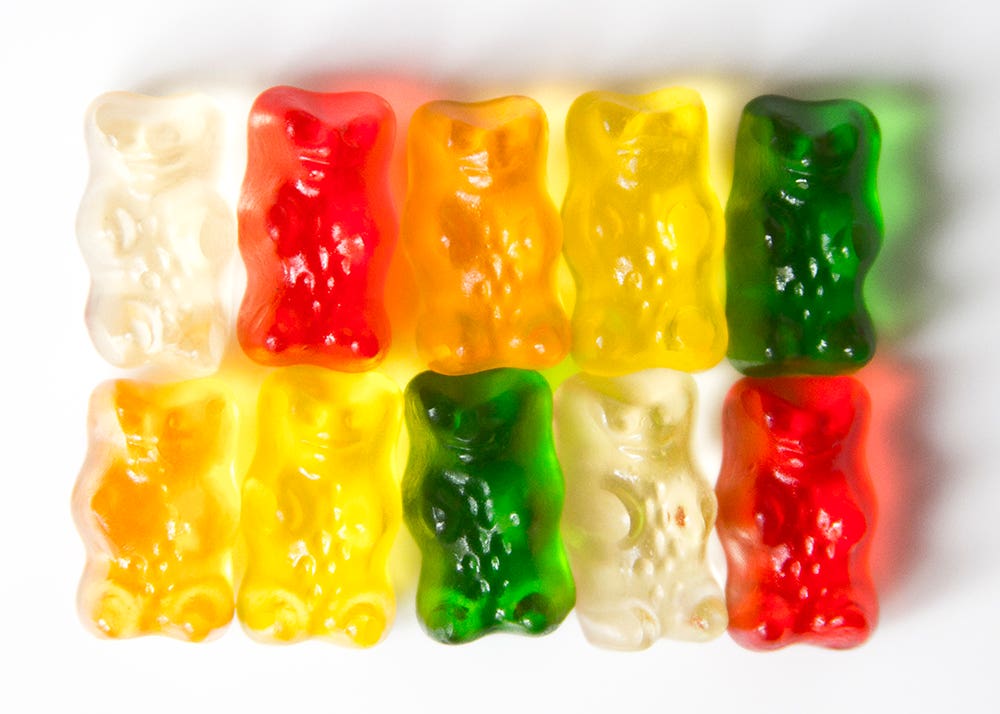
I woke up this morning to numerous emails from friends and family. Some bore the subject line “Gummi bear love,” others “RIP gummies,” all contained notes that were variations on a theme: “Saw this and thought of you,” with a link to a news story. At the age of 90, Hans Riegel, the man credited with turning his father’s small German confectionary, Haribo, makers of Haribo Gold-Bears, into a national brand, had died of heart failure—an ironic cause of death for someone who filled so many hearts with joy over the years, particularly my own.
Gummies have been my favorite food group for as long as I can remember, and in that candy kingdom the gummi bear is the uncontested crown prince. Some of my earliest memories involve going with my family to Sweet Sensations, a now-defunct candy store on 73rd and Columbus in New York City. There, you could order candies by the quarter-, half-, or full pound, the store clerks shoveling your selection into a plastic bag, weighing it, pricing it, and handing over the bounty. I was too short to see over the counter, but always ordered the same thing: a quarter pound of gummi bears, heavy on the reds if at all possible, thanks. They were always Haribo bears, the iconic European gummy brand that had been introduced to the States two years before I was born.
On our walks home from the candy story, my father, sister, and I would play a game in which we'd compete to identify each bear’s color with our eyes closed. By the age of five, I performed with near-perfect accuracy. Though I could barely tie my shoes on my own and still listened to Mousercise, I trounced my older sister, even my Dad. And with each win, I tasted not just the sweetness of the bear, but the sweetness of victory.
I've stayed loyal to Haribo through the years. The few, desperate times I ventured to try other gummi bears—say, at a gas station food mart that only offered those 99-cent rip offs—I immediately regretted it. The consistency was always wrong, the taste overpoweringly sweet. The same thing happened when I ventured the other way, toward high-end artisanal gummies, like those apricot-green tea gummy pandas you’ll sometimes find at a high-end grocery. The flavor was too fancy, the mouth feel all wrong. Haribo Gold-Bears have the perfect chew, the perfect size, and come in just the right variety of flavors—five—to keep you appreciating each one. This is all thanks to Hans, Jr., and his brother, Paul, who steered the company away from licorice bears after their father died in World War II. Under their stewardship, Haribo expanded to offer 200 different products but, unsurprisingly, the bear remains the most popular worldwide.
If I'm not feeling too gluttonous, in which case I eat them by the fistful, I respect a time-honored ritual for consuming my gummi bears: I start off with the raspberry-flavored red ones, followed by the white pineapple—a brilliant fifth flavor, in lieu of the more obvious grape—then move onto the green. I always thought they were lime-flavored, but it turns out that the flavor is strawberry, another ingenious twist. Then it's on through the orange, until all I'm left with are the yellows. I have yet to find someone who prefers these lemon-flavored bears. But when they're all you're left with, you eat them, because your worldview has shifted. And isn't it better to have a yellow bear than none at all?
Today I will honor Hans’ legacy by eating bears, loads and loads of bears. I am no longer a kid, but that's okay; Haribo's tagline gives me permission to indulge: “Kids and grown-ups love it so, the happy world of Haribo.” It's true, I do love it so. Here’s to you, Hans.
Keep Reading
Continue to Next Story










